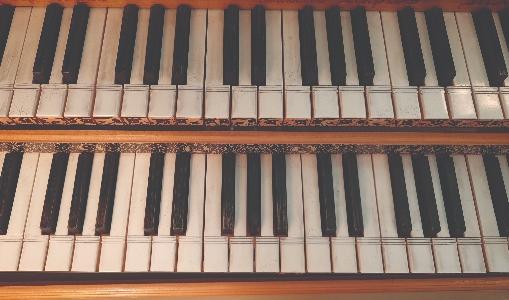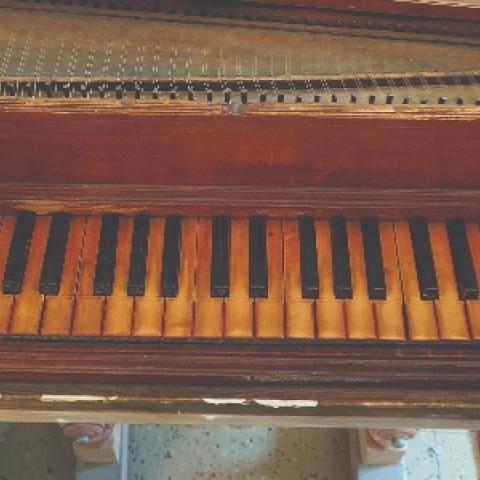Gavin Black is director of the Princeton Early Keyboard Center in Princeton, New Jersey.

The harpsichord: an introduction, part 1
This month’s column, my first after a hiatus caused by now-resolved orthopedic issues, is my first in a short series of columns about the harpsichord. Since 1990 I have presented summer workshops to introduce the harpsichord to organists and pianists. This series is based on the approach that I have taken in those workshops.
I have a desire to demystify this unfamiliar instrument. This is something that many experienced organists and pianists feel when walking up to a harpsichord, and not just because of the erroneous sense that it is a very fragile object.
I wish to share a decades-old memory, reminding me of the perils of the unknown, but also how simple it often is to learn and what a difference that can make. The first time I prevailed on a church to let me practice on their organ was when I was about thirteen. I had been sort of playing for a while but did not know very much about the organ. When I sat at this instrument and turned it on, I tried a stop or two, but then I could not get any keyboard to be silent by turning off all the stops! I was panicked—had I broken something? Would I never be able to grapple with a wondrous instrument that was this complicated? Or would I just have the unpleasant task of telling the church that their organ did not work? I left very quickly without practicing and phoned the church later to tell them that the instrument seemed broken. After doing so, I was too scared by the whole thing to ever talk to them again; I never practiced there. Of course, the whole “problem” was just that a crescendo shoe was slightly on. I had never heard of the crescendo shoe! If I had known what was up, I would have fixed the issue in a few seconds as a matter of routine and very possibly practiced on that instrument for years.
It is not possible in a few columns to include everything that there is to know about the harpsichord. I will try to frame what I write about in such a way as to point to further means of fleshing out the columns. That will include reading and listening links, but the core is to make the content open-ended and to answer some questions in ways that make it easy to answer more questions of your own. I will write about teaching harpsichord and using the harpsichord to elucidate certain facets of the organ and organ playing. This first column introduces general points, and subsequent columns will explore these in detail.
The question that I hear most from pianists and organists about the harpsichord is whether there is an advantage or disadvantage in learning to play the harpsichord if you already play another keyboard instrument? The answer, not surprisingly, is both. The disadvantages are subtle but worth being aware of—most of them fall under the umbrella of technical habits carried over from one of the other instruments to the harpsichord, when they suit the former but not the latter. The great advantage is more concrete—an organist or pianist already knows how to find notes on the harpsichord keyboard! With some careful listening and the rethinking of some aesthetic presuppositions and technical habits, an organist or pianist can start executing very satisfying harpsichord playing very promptly, certainly more than someone who is not already a keyboard player.
What is a harpsichord? To start with, it is a string instrument. It has strings or wires stretched out so that they can vibrate in a musical sound, and these strings are fitted over a resonant object to which they transmit that sound. As far as I know, that description fits every non-electric string instrument from every place and era. Therefore, the harpsichord belongs to a family that includes the piano, of course, but also the violin, guitar, mandolin, viola da gamba, hurdy-gurdy, and so on.
More specifically, the harpsichord is a plucked string instrument. This puts it into the family of the lute, guitar, vihuela, shamisen, mandolin, banjo, and so many more. This has significant implications for the way the instrument shapes the sound and the ways in which we can use the sound to shape music. The harpsichord’s status as a plucked string instrument is just as important for its own musical identity as that it is a keyboard instrument. This also has implications for the sound—the main one is that the player at the keyboard cannot change the pure volume level of the notes using variations in force. This is the chief difference between the harpsichord and the piano, though not necessarily the most important one. It is also a parallel between harpsichord and organ, since the organ swell mechanism, though it affects volume, still functions in the context of the player’s inability to control volume through pressure on the keys. More importantly, it has a strong influence on the kind of music that can be written for the instrument, and it opens the door for the harpsichord to share repertoire, players, and some aspects of technique with other keyboard instruments.
Over centuries, the harpsichord has always been grouped conceptually as much with other non-keyboard plucked instruments, the lute in particular, as with other keyboard instruments. It can be enlightening to keep this in the back of the mind.
The word “harpsichord” is an English-language name, though it probably came originally from Italian or French. The early history of the name is obscure. In other languages the instrument is usually called some variant of either the Italian cembalo or clavicembalo, or the French clavecin. For example, cembalo is the German name, and variants of clavecin are used in Spanish, Russian, Polish, and so on. There have always been different shapes and sizes of instruments that are fundamentally similar to the harpsichord or close variants of the harpsichord. Some of these are wing-shaped in the manner, more-or-less, of a grand piano. Those are the ones that have been most reliably called “harpsichord” over the centuries. There are also rectangular variants, often called spinet or virginal. There are pentagonal instruments, also often called spinet, and more rarely there are various other shapes. There are harpsichord-type instruments that are upright in the manner of upright pianos. For purposes of this discussion and in a manner that reflects the usage of the instruments over the years, I will normally mean any and all of these variants when talking about harpsichords. If there are distinctions that need to be made I will note them.
The harpsichord was in its day also a workhorse instrument. At any time over the last centuries there was some sort of keyboard instrument that was typically found in homes, rehearsal spaces, churches, schools, coffee houses, bars—any place where music-making occurred—and that served the practical needs of working musicians, not just the need for effective performance tools, but also all needs associated with practicing, drilling, teaching, demonstrating, figuring things out, and so on. For several centuries, harpsichords filled a large part of this need. Of particular interest here is that for many years organists did a significant portion of their practicing on a harpsichord, and sometimes a clavichord. Practicing on an organ itself required the assistance of someone else to pump the wind, until the mid- to late-nineteenth century. Before then this was a cumbersome process. In due course the harpsichord and clavichord were replaced in the everyday role by the piano, which in its turn is now being replaced for these sorts of purposes by electronic keyboards. We do not know how thorough this transformation will be, but it is at least a possibility that it will in due course become pervasive and that the piano in the traditional sense will be redefined as a specialized art instrument, as the harpsichord now largely is.
A harpsichord is a tool designed to produce a sound that people will react to as compelling, intense, interesting, beautiful, a sound that has that sort of quality intrinsically, regardless of any compositional content, and essentially independent of how it is played. The exact same thing is true of the organ. To me, this is the real bond between the two instruments, more than the fact that both are keyboard instruments and have a significant shared repertoire. Presumably, most people involved with making or listening to music expect the net overall effect of a musical performance to have these qualities. But with every sort of music making there is a different balance as to where this kind of musical and emotional effectiveness comes from. And with instruments whose sonorities cannot be changed very much by the player, the instrument itself, as created and delivered by the instrument maker, provides a larger proportion of that effectiveness than with instruments that can be shaped and varied as they are played.
Like the organ, the harpsichord is an instrument with stops. An instrument has a number of discrete, discernibly different sounds, and they can be used by the player separately or together in various patterns determined in part by the distribution of those sounds over different keyboards. Any organist can get comfortable with this aspect of the harpsichord right away. The most evident difference between the organ and the harpsichord in the matter of stops is that harpsichords have fewer stops than all but the smallest organs. This is in part of necessity and in part through choices. There are harpsichords with only one stop. In fact, most of the variants—virginals, spinets, and so on—are one-stop instruments. Two or three stops is normal, sometimes there are four or five, and that’s about it. Unlike with all but the smallest organs, choosing stops for a given musical situation by just trying everything is actually a practical possibility. In the history of harpsichord building, instruments with two 8′ stops and nothing else have been very common indeed. So have instruments with one 8′ and one 4′ or two 8′ and one 4′ stops. The latter usually implies three sets of strings. It is rare for a harpsichord to have more than that, though not impossible or unheard-of. In the heyday of the harpsichord there were a few instruments with 16′ stops and a very, very few with 2′ stops. To a large extent “stops” correspond to “sets of strings,” but not entirely. There are ways to make a given set of strings provide more than one sound, and I will get into some of the details of this later.
This hints at my last general point here. The harpsichord and its variants were and are highly non-standardized. Standardization is a flexible concept—no two pianos, clarinets, golf clubs, or just about anything else are absolutely identical. But with the harpsichord this is about not just the nuances of sound of touch or the even disposition of stops. It extends to compass, size of keys, the nature of the coupling mechanism, sometimes the distribution of notes or pitches to the keys, and much more. The accompanying photograph is a small appetizer to later more detailed discussion of this bewildering variety. It is a close-up of a two-manual harpsichord in which the two keyboards are not aligned and do not play the same pitches as each other—strange until you know what is going on! There are fascinating reasons that the harpsichord developed this way—or that the modern snapshot that we have of an instrument that thrived between 200 and 600 years ago looks like this. Over the next few columns I will discuss the harpsichord mechanism and set-up as well as harpsichord sound in considerable detail.





